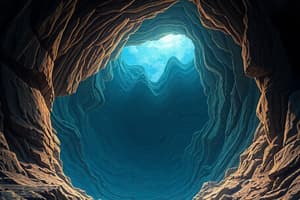Podcast
Questions and Answers
What are the three main layers of the Earth?
What are the three main layers of the Earth?
Crust, Mantle, Core
Seismic waves are waves of energy that are generated by an __________ or other earth vibrations.
Seismic waves are waves of energy that are generated by an __________ or other earth vibrations.
earthquake
Which of the following is a characteristic of Primary waves?
Which of the following is a characteristic of Primary waves?
- Can travel through solids, liquids, and gases (correct)
- Particle motion is perpendicular to wave propagation
- Travel slower than S-waves
- Also known as shear waves
What type of wave cannot travel through liquid?
What type of wave cannot travel through liquid?
What is the difference between surface waves and body waves?
What is the difference between surface waves and body waves?
Rayleigh waves travel faster than Love waves.
Rayleigh waves travel faster than Love waves.
What do seismologists use to study the Earth’s interior?
What do seismologists use to study the Earth’s interior?
The highest point of a wave is called the __________.
The highest point of a wave is called the __________.
The __________ of a wave is the time it takes for the wave to pass a fixed point.
The __________ of a wave is the time it takes for the wave to pass a fixed point.
Seismic waves help to locate and understand fault lines.
Seismic waves help to locate and understand fault lines.
Flashcards are hidden until you start studying
Study Notes
Layers of the Earth
- The Earth consists of three primary layers: Crust, Mantle, and Core.
- The Core is further divided into the Outer Core and Inner Core.
Seismic Waves
- Energy waves generated by earthquakes or vibrations that travel through the Earth or along its surface.
- Seismologists utilize seismographs to record the travel time of seismic waves, analyzing their behavior through different layers based on variations in density and stiffness.
Wave Characteristics
- Crest: The highest point of a wave.
- Trough: The lowest point of a wave.
- Amplitude: Measured distance from the undisturbed surface to either the crest or trough.
- Wavelength: Distance over which the wave repeats, typically measured from crest to crest.
- Wave height: Vertical distance from crest to trough.
- Period: The time for one complete wave cycle to pass a given point.
- Frequency: The number of waves that pass a specific point per unit time.
Types of Seismic Waves
-
Body Waves: Travel through the Earth's inner layers, used for studying the Earth's interior, generally at a higher frequency than surface waves.
- Primary Waves (P-waves):
- Fastest seismic waves, first detected by seismographs.
- Move through solids, liquids, and gases by compressing and expanding the medium.
- Secondary Waves (S-waves):
- Travel slower than P-waves, cannot move through liquids.
- Particle motion is perpendicular to wave direction, causing rocks to move vertically or side-to-side.
- Primary Waves (P-waves):
-
Surface Waves:
- Restrained to the Earth's surface, arriving after body waves and often highly destructive.
- Generated by earthquakes that originate near the surface.
Sub-types of Surface Waves
-
Love Waves:
- Named after mathematician Augustus Edward Hugh Love.
- Slightly faster than Rayleigh waves, cause horizontal, side-to-side ground motion and are responsible for significant damage.
-
Rayleigh Waves:
- Named after Lord Rayleigh, who predicted their existence.
- Travel as ripples, similar to water surface waves, and can be observed affecting objects like cars during an earthquake.
Importance of Studying Seismic Waves
- Analyzing different wave behaviors helps deduce the Earth's compositional layers.
- Understanding seismic waves aids in locating fault lines and assessing geological stress and strain.
- Used in natural resource exploration, such as oil and gas, through controlled explosions or ground vibrations.
Differences between Surface and Body Waves
- Surface waves travel along the Earth's surface and arrive after body waves at seismic stations, while body waves penetrate the Earth's interior.
Seismologists' Focus
- Body waves are crucial in studying the Earth's interior since they can traverse through inner layers, giving insights into geological structures.
Studying That Suits You
Use AI to generate personalized quizzes and flashcards to suit your learning preferences.



